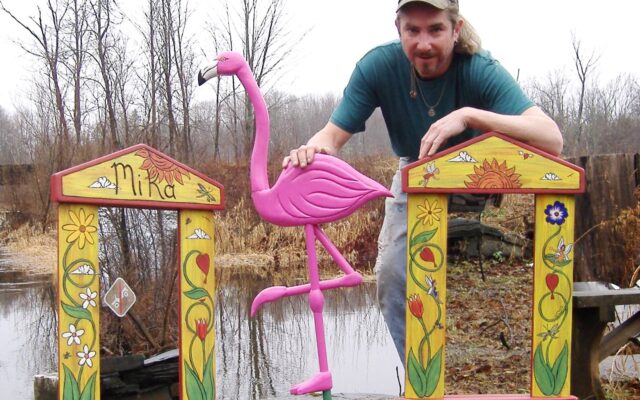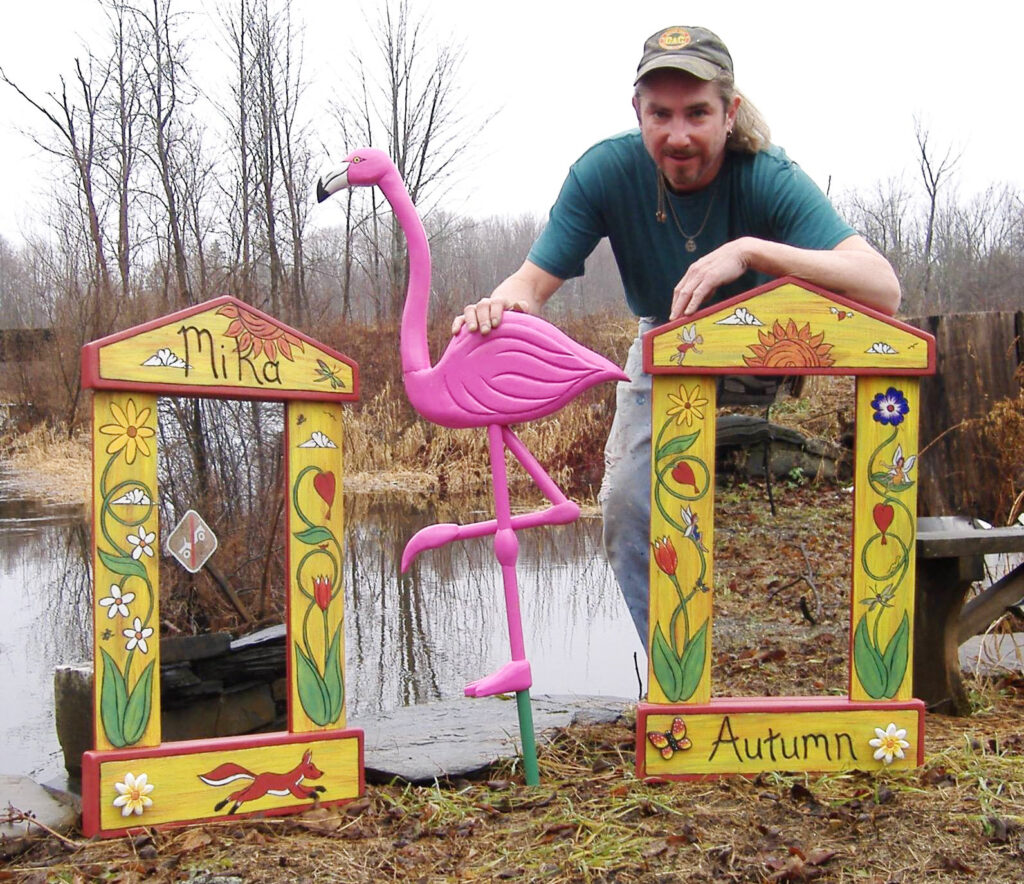
The man who ran Piscataquis County’s Enchanted Forest can’t wait to get back to the woods
By Emily Burnham, Bangor Daily News Staff
Once upon a time, in a land not very far away, there was a man who lived near an enchanted forest. His name was Paul Stiffler, and for nearly a decade between 1995 and 2004, he maintained and built sculptures for an “art playground” known as the Enchanted Forest, located in Sangerville.
Stiffler, now 56, has always worked in the woods, whether it was as a logger in Maine’s forestry industry, as the proprietor of a nationally acclaimed woodworking studio making wooden toys, as a “trail angel” on Maine’s 100-Mile Wilderness stretch of the Appalachian Trail, or as a wood sculptor, creating whatever comes to mind out of raw blocks of pine.
After years of struggling with mental and physical challenges, however, Stiffler is ready to return to the woods — and to get back to his craft.
“I’m not a city person. I am definitely a country person,” said Stiffler, who has ridden out the pandemic while recovering from a major back injury in Framingham, Massachusetts, living with his mother. “I cannot wait to get back to the woods, and to Maine.”

WORKS OF ART — Paul Stiffler, a woodworking artist from Piscataquis County, poses with some of his creations in this 2017 photo.
Most people who grew up in Piscataquis County in the 1980s or ’90s likely remember the Enchanted Forest. Started in 1981 by a local self-taught artist named Ardell Flanders as a retirement hobby, it began as a simple pine grove on Flanders’ property, where he placed his whimsical folk art sculptures — unicorns, trolls, a pirate ship and a menagerie carved out of wood with a chainsaw.
“I’d take my kids over to visit, when they were little,” Stiffler said. “Everybody knew about it. Ardell let anybody come visit. It was open to everybody. Everybody loved it.”
Eventually Stiffler, who throughout his early and mid-20s worked in Maine’s forestry industry, decided to try his hand at chainsaw sculpture. A few carvings later, he was hooked, and started taking woodworking classes through local adult education.
Those classes led to Stiffler starting his own small business in 1992, making carved wooden toys — Heritage Toys and Collectibles, based in Sebec. Over the course of 12 years, Stiffler had hired more than 20 employees, and would see his work sold in shops all over the country and the world, and even end up on display at the White House during the Clinton administration.
Meanwhile, as word spread about the unusual sculpture park and playground in Sangerville, its popularity began to overwhelm Flanders, who at that point was in his mid-1970s. He was also worried that kids might injure themselves on his rough-hewn work, as he could not afford to insure the place. In 1995, Flanders turned over all his sculptures and management of the project to Stiffler, who moved them to a new location on Douty Hill Road in Sangerville, and the local Kiwanis Club agreed to pay for insurance.
As he ran his wooden toy business, Stiffler also began creating new and ever more elaborate sculptures for the Enchanted Forest, like Lucy Van Pelt’s psychiatry stand from “Peanuts,” a scene from “The Cat in the Hat” and an entire puppet theater, complete with a stage and wooden puppets kids could use. The overall effect was reminiscent of iconic Maine sculptor Bernard Langlais, whose wooden sculptures can still be seen at his sculpture park in the town of Cushing.
Around 2005, Stiffler’s life turned upside down. As a child, he suffered abuse from his father. For years, he was able to keep the symptoms of post-traumatic stress disorder under control, but by his late 30s, the trauma of his childhood came roaring back into his mind. He began to experience what he would call “gray-outs,” in which the world simply went blank and closed in on him.
With his life unraveling, he declared bankruptcy and went on disability, rarely venturing out of his home in Dover-Foxcroft or talking to anyone.
“Nobody wanted to talk about mental illness back then,” he said. “Trauma keeps coming up in my life, even if I didn’t recognize it most of the time. A lot of my actions have been based on that. I’m still trying to heal from it. It’s hard. It’s hard every day.”
He also closed up the Enchanted Forest, and began selling off or giving away his sculptures to local people. Presently, Stiffler doesn’t know where, exactly, any of the remaining sculptures are, though he knows there are at least a few hidden away in barns and backyards in Piscataquis County.
“People definitely still remember it,” he said. “I think it was a big part of a lot of people’s childhoods. It was a place where you could use your imagination. There wasn’t anything else like it around.”
After a long period of being a recluse, eventually, Stiffler mustered up the courage to get outside and start taking long walks in the woods — walks that put him on the path to healing, and to a new chapter in his life.
Out in the 100-Mile Wilderness — the legendary section of the Appalachian Trail between Monson and Baxter State Park — Stiffler began encountering thru-hikers. As he learned their stories, he became what hikers call a “trail angel.” He began to help them, offering up food, rides and personal hygiene supplies — anything to help lighten the load during the last miles of their epic journey from Georgia to Maine.
“Being out there really helped me find some peace,” he said. “I still struggle with anxiety attacks. I still have a lot of pain. But I have learned to manage it better. I just take it one day at a time.”
In 2019, Stiffler was preparing to move out of his home in Dover-Foxcroft and into a new place nearby. While moving, he suffered an injury that gave him a compression fracture in two vertebrae, causing agonizing pain that made him unable to walk. His family quickly moved him down to Massachusetts, where he’s spent the past two years in therapy — both physical and psychological.
Provided everything goes as planned, by this time next year, Stiffler hopes to find a place to live somewhere near Monson, where he can reclaim his tools and saws from their storage place and get back to the work of making magic out of wood.
“The past two years have been awful. I’ve never been so bored in my life,” he said. “I’m really grateful for all the help I’ve gotten, but I am so ready to go back to the woods. I want to get back to my wood shop. I want to start creating again. That’s always where I’ve been my happiest.”